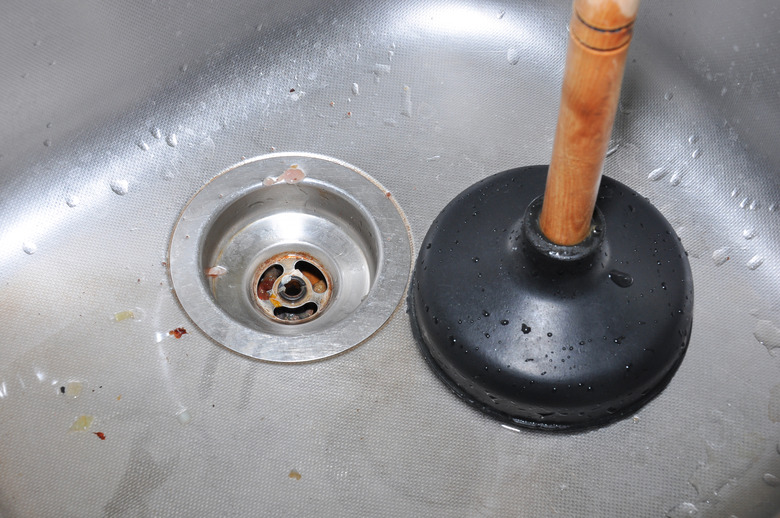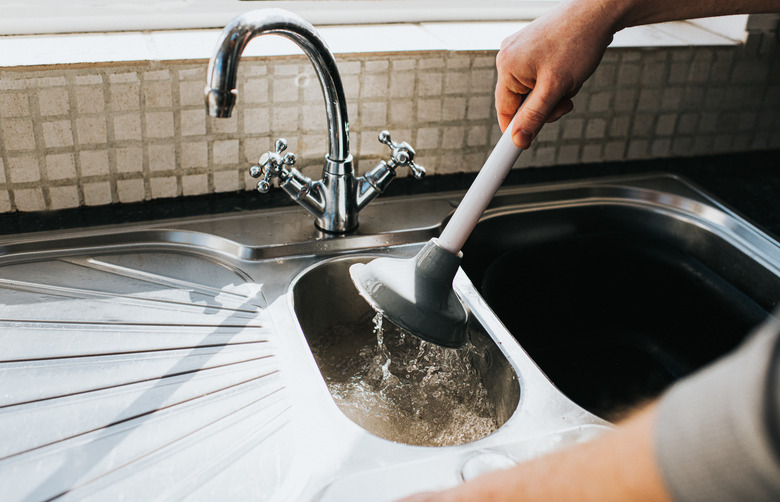Is My Garbage Disposal Stuck Or Dead?
A garbage disposal is one of those modern conveniences that goes underappreciated in the kitchen until it malfunctions. Jams, leaks, or frequent clogs are all signs that something's awry with your garbage disposal. In some cases, simply removing the cause of a clog or jam can get it up to functional speed once again, but if the housing is rusted, your food waste disposer most likely needs to be replaced.
If the disposal hums when you turn it on but nothing else happens, it's either a jam or a faulty motor. Since jams are common issues and are relatively easy to fix, many common disposals have a fitting on the bottom of the unit for inserting and turning an Allen wrench. This often clears the clog or jam and allows the inner workings to spin again, restoring the disposal's ability to function properly. If the disposal makes other strange noises when you use it, such as clinking sounds, something could be in the disposal, so diagnosing a jam or a foreign-object problem is another way to tell if the disposal is broken or just needs to be cleared out.
How to Fix a Jammed Garbage Disposal
The easiest way to diagnose a humming disposal is to first treat the problem as if it's a jam — and luckily this is an easy enough DIY project for any homeowner to do. If this is the issue and you successfully clear it, your disposal works fine again afterward. If unjamming it doesn't work, there's a good chance it needs to be replaced. Before starting, make sure the disposal's switch is off, or better yet, unplug it as well. Turning off the power at the circuit breaker is another option. Also remove any standing water in the sink.
1. Use an Allen Wrench
Garbage disposals such as InSinkErator come with an Allen wrench that fits into a hole in the center of the bottom of the disposal housing under the sink. If you can't find the wrench that came with the disposal, use a 1/4-inch Allen wrench. Work the wrench clockwise and counterclockwise using force as needed until the wrench moves easily. Keep working until you're able to move the wrench in complete rotations in each direction. If your disposal is a brand that doesn't have the wrench hole, read the product information or contact the company to determine the best way to clear a jam to ensure it's done safely and as recommended by the company.
2. Test the Disposal
Turn the power back on for the disposal by plugging it back in or switching it back on at the breaker box. Flip the switch to turn the disposal back on and test it. If you've solved the problem, the garbage disposal should function as it did before the issue. If not, continue to the next options.
3. Push the Reset Button
Inspect the bottom of the disposal beneath the sink for a red button, which is an overload protector switch. If the overload tripped at any point, this button should be sticking out quite a bit. Push it in and it should stay in; if it pops back out, wait another 10-15 minutes and try again. Test the unit once again by running the disposal. If the overload reset did the trick, the disposal should work.
4. Look Inside the Disposal
If resetting and unjamming the disposal didn't work, turn off the power to the disposal once again. Shine a light inside the disposal opening in the sink, looking for items that could be responsible for a major jam, such as cutlery or even food-related items that shouldn't go down the disposal, such as coffee grounds or eggshells. Check near the outer perimeter of what's visible in the grinding chamber and remove anything you find with tongs but not your hand. After you've removed any obstructions, plug the disposal back in and run the water. Turn the disposal on again and it should work.
5. If All Else Fails
If your disposal still doesn't work, it may be under warranty for service or replacement. Look on the disposal itself or in the booklet that came with it for the manufacturer name and the manufacture date. Call the company to find out whether it will send a technician out to investigate the issue. If the disposal hums and still doesn't move, it's a sure sign that it is getting power, so it's not a matter of a tripped circuit or a blown fuse. Once you've tried everything and the disposal hums without doing anything else, it's time to replace it.
Disposal Doesn't Grind Well
If the disposal doesn't seem to grind food well, one of the impellers may have an object blocking its movement. Shine a flashlight inside the disposal looking for any foreign objects, such as a coin, a ring, or a cigarette butt. If you don't see anything, use a spoon handle to move the impellers, which should move freely. If they don't, grind some harder objects, such as fruit pits, which should free this type of problem. If this works, the disposal is free to grind well once again.
When the disposal sounds like it's running properly but still isn't doing its job well, there may be stringy food matter stuck somewhere within the disposal, such as on the impellers or the shredder ring. Grind some ice cubes to clear this type of issue and to give it a good cleaning. If that still doesn't solve the problem, it's probably time to replace the disposal, as most of the parts inside it aren't replaceable.
Frequent Drain Clogs
Frequent clogs could be due to the types of items going into the disposal. Never put greasy matter, such as chicken skin, cooking oils, or grease, into the disposal or any sink drain, as these eventually cause clogs. Oatmeal, rice, and pasta expand when wet and are also good at creating clogs. Stringy fruit and vegetable matter, potato peels, onion skins, and eggshells are also problematic. Be sure to tell children and others in the household about what should and shouldn't go through the garbage disposal.
Try plunging the sink a few times to clear the issue. If that doesn't work, it may be worth calling a plumber to determine whether the issue is a drain clog or a problem with the disposal itself. If it is the disposal, it's time to replace it. If the side of the sink with the disposal backs up frequently or into your dishwasher even though you don't use the disposal, this also indicates problems with the disposal in many cases. It's time for a new one.
Rust Usually Means Replacement
If you see rust on the outer housing of the garbage disposal, as in the area visible beneath the sink, there's a good chance it's rusted through. The catch here is that you probably won't notice the rust until there's a hole or crack large enough to cause a leak, in which case you'll see the water and track its source.
If you use your garbage disposal regularly and notice water under the sink, first look and feel for water around all the pipes and connections beneath the sink, as the problem might be fixable, such as a loose drain line or a poor seal where the disposal connects to the sink. If you notice water in the area beneath the disposal itself and your disposal is more than five years old, it's a good idea to look for a crack or hole in the housing.
Inspect the entire garbage disposal body or housing beneath the sink with a flashlight, looking for water droplets coming from the disposal body. Feel your way around the outside of the disposal if you can't visibly find the issue or use a paper towel to dab certain areas to locate moisture. Use a mirror in conjunction with a flashlight to help find leaks on the side of the disposal housing closest to the back wall. A smartphone camera in selfie mode is another way to get a glimpse of what's happening on the back of the disposal; be sure to turn on the flash to get a good shot. If there is a small crack or rust hole, you'll find it most easily after running the disposal, as a little water will find its way to the problem spot.
Due to the nature of the design, the average garbage disposal is prone to rust as the disposal ages toward the end of its useful life span. In this case, it may still function properly as far as grinding food, but if it's spraying water all over the place beneath the kitchen sink, it's time for a new garbage disposal.

